Ceramic Cider Mug
Object
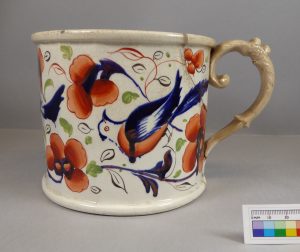
A large ceramic cider mug (large beaker body and handle) decorated with painted chinoiserie bird and floral decoration and leaded glaze. It is possibly a Mason’s Ironstone cider mug.
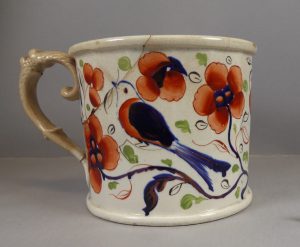
At the beginning of the 19th century pottery began to replace pewter in the manufacture of drinking vessels. It was the ‘trophy’ shape of the loving cup that the potteries began to emulate, decorated with a tin glaze and either hand painted or transfer printed. By the 1850s, particularly in the south west of England, earthenware mugs and jugs took the place of pewter in the pubs and cider houses.
Condition

- Evidence of previous restoration in the form of an orange/brown adhesive present along all joins and some overspill is clear
- It was clear from visual examination of the old joins that there was evidence of stepping, and some areas were not in contact with one another
- The ceramic was badly stained, with significant tidelines possibly related to its reassembly and subsequent use for food storage where food has entered the body of the ceramic
- Signs of dust and dirt on the surface and especially in the interior.
Conservation
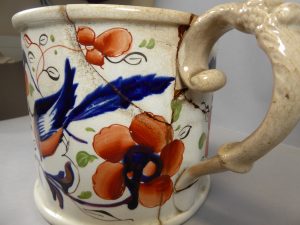
The original adhesive on the cider tankard was analysed visually after the analytical equipement within the laboratory returned inconclusive results. Using this method the adhesive was thought to be either animal glue or shellac. As the adhesive fluoresced orange under long-wave UV light, the conclusion was that it was likely a form of shellac. Knowing this would help when it came to trying to take down the old joins and remove the old adhesive.
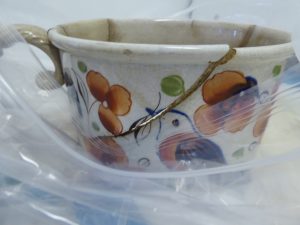
Initially the ceramic was cleaned using a solution of 50:50 ethanol / deionised water with a few drops of Synperonic A7 applied using dampened cotton swabs. This would remove the initial dust and dirt from the surface and would allow a better idea of how severe the staining was. Once this initial clean was completed the ceramic was rinsed using 50:50 ethanol / deionised water in order to remove the detergent residue.
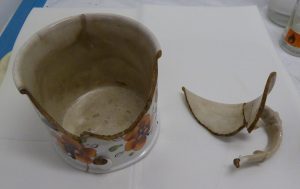
In order to take down the joins of the tankard and remove the old adhesive, small samples of the adhesive were immersed in different solvents to understand the adhesives solubility parameters. The adhesive responded most to ethanol where following a 1 hour immersion it became rubbery and could be easily torn.
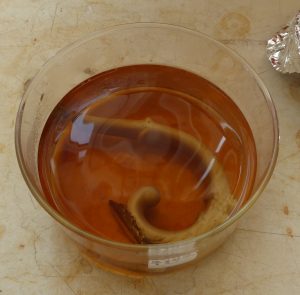
In order to take down the joins, the ceramic was placed into a sealed finds bag alongside cotton wool soaked in ethanol to create an ethanol vapour rich environment. The ceramic remained in this environment over-night and the following day the sherds could be detached from each other. The remaining surface adhesive was then removed using a combination of a solvent gel, to soften the adhesive, and wooden tools, and a scalpel to fully remove the adhesive.
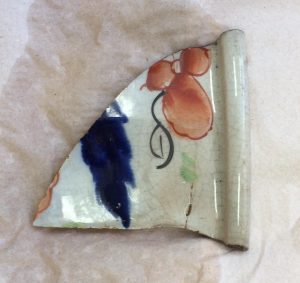
One the ceramic had been taken down the aim was to attempt stain removal before re-adhering the sherds. Initially the ceramic was soaked in baths of deionised water to remove the ingrained staining from the sherds over the course of 3 weeks; the bath of deionised water was changed once the water became visibly soiled and yellow. Towards the end of the three weeks the yellowing of the water slowed yet visible staining remained.
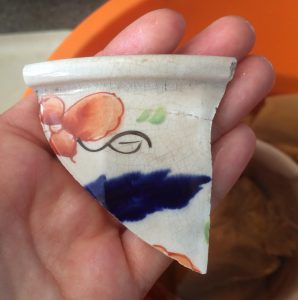
Subsequently, following testing to ensure safe use, the ceramic was soaked in a 5% solution of BioTex (enzymatic commercial laundry detergent) in deionised water in order to try and remove further staining. This solution was warmed during preparation and maintained at a moderate temperature over the course of cleaning to encourage the activity of the enzymes.
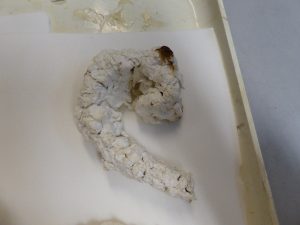
The sherds were left to soak in the BioTex solution for 2 hours, followed by detailed cleaning of the furface using a stiff bristled brush to remove excess residue. They were then placed in successive baths of deionised water for 2 days before being rinsed under a running stream of lukewarm tap water for 8 hours and then finally being placed in final bath of deionised water.
The process of cleaning with BioTex was repeated two more times. The ceramic still remained stained though it had visibly lessened. If more time had been available, this process would have been repeated to further reduce the extent of staining.
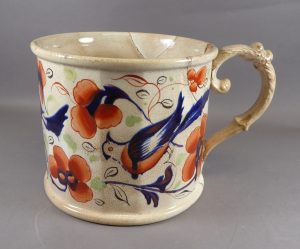
Following BioTex treatment the ceramic was allowed to air-dry over the course of several days where it became clear that the source of staining was being drawn below the glaze causing the it to become more noticeable. The ceramic was then placed back into a bath of deionised water in an attempt to encourage further diffusion of this staining. Once removed from the bath the ceramic was coated in paper pulp soaked in deionised water and allowed to air-dry. The paper pulp worked to draw out more of the staining, however as the staining was extensive some remained.

As time was a factor, further stain removal couldn’t be attempted and so they ceramic tankard required reassembly. The sherds were adhered together using Paraloid B-72 adhesive. The joins were supported using masking tape and areas which had sprung slightly were brought back into alignment using cotton tape which was tied around the diameter of the ceramic and used to create a tourniquet to tighten the ceramic into alignment. Following curing (several days) the support materials were removed.
